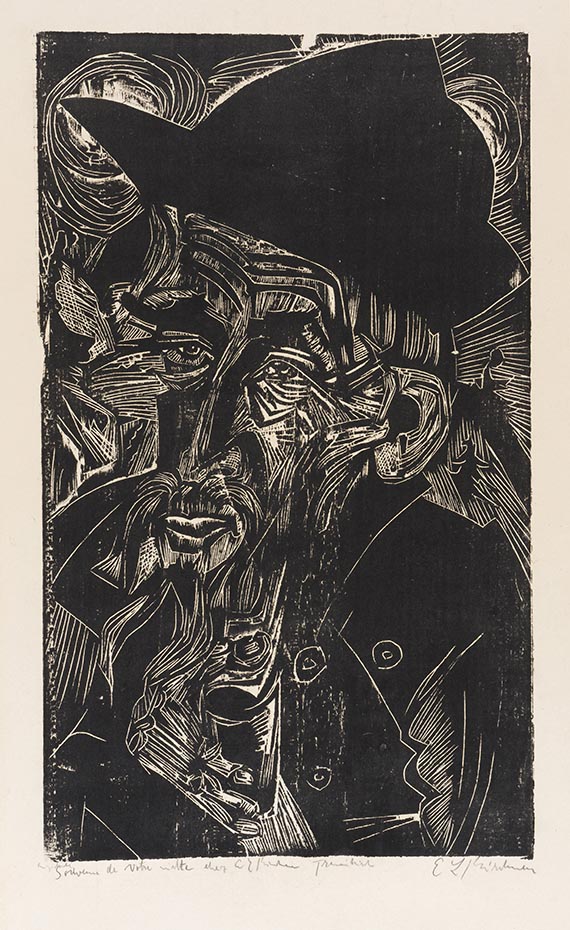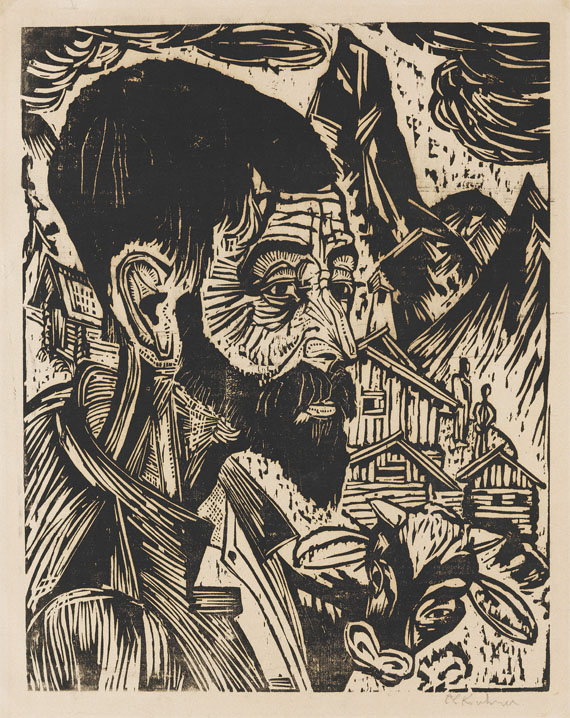Sale: 554 / Modern Art Day Sale, June 08. 2024 in Munich  Lot 122000552
Lot 122000552
 Lot 122000552
Lot 122000552
122000552
Ernst Ludwig Kirchner
Alter bärtiger Älpler in schwarzem Hut (Kaspar Cadiepolt), 1919.
Woodcut
Estimate:
€ 30,000 - 40,000
$ 32,100 - 42,800
Information on buyer's premium, taxation and resale right compensation will be available four weeks before the auction.
Alter bärtiger Älpler in schwarzem Hut (Kaspar Cadiepolt). 1919.
Woodcut.
Signed and inscribed "Eigendruck" and with the dedication "Souvenir de votre visite chez E. L. Kirchner Frauenkirch". One of only 18 known copies of this woodcut and of just 9 copies from this printing state. On firm wove paper. 58 x 34.7 cm (22.8 x 13.6 in). Sheet: 70 x 41,5 cm (27,5 x 16,3 in).
The work ist registered in the Hermann Gerlinger Collection with the number SHG 781 a. [CH].
• Hand-made print of particularly good quality.
• Of the only nine known copies from this state of printing, three are museum-owned: the Milwaukee Art Museum, the Städel Museum, Frankfurt am Main, and the Kirchner Museum, Davos.
• One of the most famous print portraits of the Davos period.
• In the year of its creation, Kirchner also captured the striking face of the elderly farmer in an etching (Gercken 1024), a photograph (Kirchner Museum, Davos) and in a painting in oil on canvas (Gordon 622).
• E. L. Kirchner mentioned working on the woodcut in his 1919 diary on several occasions .
PROVENANCE: Hermann Gerlinger Collection, Würzburg (with the collector's stamp, Lugt 6032, acquired in 2013, Galerie Kornfeld, Bern).
EXHIBITION: Kunstmuseum Moritzburg, Halle an der Saale (permanent loan from the Hermann Gerlinger Collection, 2001-2017).
Buchheim Museum, Bernried (permanent loan from the Hermann Gerlinger Collection, 2017-2022).
LITERATURE: Gustav Schiefler, Die Graphik Ernst Ludwig Kirchners, vol. 2 (1917-1927), Berlin-Charlottenburg 1931, no. H 407.
Annemarie and Wolf-Dieter Dube, E. L. Kirchner. Das graphische Werk, Munich 1967, no. H 411 a II (of III).
Günther Gercken, Ernst Ludwig Kirchner. Kritisches Werkverzeichnis der Druckgraphik, vol. 4 (1917-1919), Bern 2015, no. 1075 II (of III, illu.).
- -
Galerie Kornfeld, Bern, 258th auction, Kunst des 19. bis 20. Jahrhunderts, part 1, June 14, 2013, p. 132, lot 61 (full-page illu., p. 133).
"Bold's head has turned out quite nice."
E. L. Kirchner about working on this woodcut, diary entry on October 3, 1919, quoted from: Lothar Grisebach (ed.), Ernst Ludwig Kirchners Davoser Tagebuch, Wichtrach/Bern 1997, p. 54.
Woodcut.
Signed and inscribed "Eigendruck" and with the dedication "Souvenir de votre visite chez E. L. Kirchner Frauenkirch". One of only 18 known copies of this woodcut and of just 9 copies from this printing state. On firm wove paper. 58 x 34.7 cm (22.8 x 13.6 in). Sheet: 70 x 41,5 cm (27,5 x 16,3 in).
The work ist registered in the Hermann Gerlinger Collection with the number SHG 781 a. [CH].
• Hand-made print of particularly good quality.
• Of the only nine known copies from this state of printing, three are museum-owned: the Milwaukee Art Museum, the Städel Museum, Frankfurt am Main, and the Kirchner Museum, Davos.
• One of the most famous print portraits of the Davos period.
• In the year of its creation, Kirchner also captured the striking face of the elderly farmer in an etching (Gercken 1024), a photograph (Kirchner Museum, Davos) and in a painting in oil on canvas (Gordon 622).
• E. L. Kirchner mentioned working on the woodcut in his 1919 diary on several occasions .
PROVENANCE: Hermann Gerlinger Collection, Würzburg (with the collector's stamp, Lugt 6032, acquired in 2013, Galerie Kornfeld, Bern).
EXHIBITION: Kunstmuseum Moritzburg, Halle an der Saale (permanent loan from the Hermann Gerlinger Collection, 2001-2017).
Buchheim Museum, Bernried (permanent loan from the Hermann Gerlinger Collection, 2017-2022).
LITERATURE: Gustav Schiefler, Die Graphik Ernst Ludwig Kirchners, vol. 2 (1917-1927), Berlin-Charlottenburg 1931, no. H 407.
Annemarie and Wolf-Dieter Dube, E. L. Kirchner. Das graphische Werk, Munich 1967, no. H 411 a II (of III).
Günther Gercken, Ernst Ludwig Kirchner. Kritisches Werkverzeichnis der Druckgraphik, vol. 4 (1917-1919), Bern 2015, no. 1075 II (of III, illu.).
- -
Galerie Kornfeld, Bern, 258th auction, Kunst des 19. bis 20. Jahrhunderts, part 1, June 14, 2013, p. 132, lot 61 (full-page illu., p. 133).
"Bold's head has turned out quite nice."
E. L. Kirchner about working on this woodcut, diary entry on October 3, 1919, quoted from: Lothar Grisebach (ed.), Ernst Ludwig Kirchners Davoser Tagebuch, Wichtrach/Bern 1997, p. 54.
It was because of his poor health that E. L. Kirchner traveled to Davos to seek medical treatment from Dr. Frédéric Bauer, then head physician at the Davos Park Sanatorium, on several occasions as of 1917. Eventually, he and his partner Erna Schilling moved to Switzerland for good. From September 1918 to 1923, Kirchner lived in the winter-proof cottage "In den Lärchen", which he rented from the Müller family, farmers from the farm group "In den Lärchen" above Längmatte in Frauenkirch. The Alpine landscape, the hard-working local farmer families and the bucolic village idyll were important sources of inspiration for Kirchner during these years. "I am so happy and glad to stay here. Here I can at least get some work done on good days and be quiet among these simple and good people," Kirchner wrote to Henry van de Velde on July 5, 1919 (quoted from: Ernst Ludwig, Briefe an Nele und Henry van de Velde, Munich 1961, p. 99).
From then on, he worked with impressive creative energy on prints, drawings, watercolors, paintings and later even wooden sculptures and pieces of furniture. Around 1918/19, he created very impressive woodcuts of members of the farmer families, works that count among the highlights of Kirchner's graphic oeuvre. In the woodcut offered here, Kirchner portrays Kaspar Cadiepolt (1846-1923), also known as "Old Bold". Cadiepolt used to be a farmer in Davos Monstein and in Kirchner's days - following the sale of his own farm after his divorce - worked as a milker on the farm of the Biäsch family and was in charge of the animals on the Stafelalp. His daughter Anny married the young farmer David Müller, whom Kirchner had also portrayed in a woodcut in 1919 (Gercken 1094). In his diary, the artist mentions working on the wooden block for the portrait of Cadiepolt several times. September 14, 1919: "Painted and drew Old Bold." (Lothar Grisebach/Lucius Grisebach (ed.), Ernst Ludwig Kirchner. Davoser Tagebuch, Ostfildern-Ruit 1997, p. 52) and on October 3, 1919: "Bold's head has turned out quite nice." (Ibid., p. 54) There is also a brief note on October 8, 1919: "Woodcut of Bold". (Ibid.)
The interest in the faces and characters of the people living in Davos, as well as the significance of this motif and model, is evident in the large number of works of Cadiepolt: In the same year, Kirchner also captured the striking visage of the elderly farmer in an etching (Gercken 1024), a photograph (Kirchner Museum, Davos) and later in the painting "Alter Bauer" (1920, Gordon 622). The woodcut created in 1919, of which the catalogue raisonné (Gercken) mentions a total of only nine copies (three of which are in museum possession), is considered to be one of the most outstanding woodcut portraits in E. L. Kirchner's oeuvre. [CH]
From then on, he worked with impressive creative energy on prints, drawings, watercolors, paintings and later even wooden sculptures and pieces of furniture. Around 1918/19, he created very impressive woodcuts of members of the farmer families, works that count among the highlights of Kirchner's graphic oeuvre. In the woodcut offered here, Kirchner portrays Kaspar Cadiepolt (1846-1923), also known as "Old Bold". Cadiepolt used to be a farmer in Davos Monstein and in Kirchner's days - following the sale of his own farm after his divorce - worked as a milker on the farm of the Biäsch family and was in charge of the animals on the Stafelalp. His daughter Anny married the young farmer David Müller, whom Kirchner had also portrayed in a woodcut in 1919 (Gercken 1094). In his diary, the artist mentions working on the wooden block for the portrait of Cadiepolt several times. September 14, 1919: "Painted and drew Old Bold." (Lothar Grisebach/Lucius Grisebach (ed.), Ernst Ludwig Kirchner. Davoser Tagebuch, Ostfildern-Ruit 1997, p. 52) and on October 3, 1919: "Bold's head has turned out quite nice." (Ibid., p. 54) There is also a brief note on October 8, 1919: "Woodcut of Bold". (Ibid.)
The interest in the faces and characters of the people living in Davos, as well as the significance of this motif and model, is evident in the large number of works of Cadiepolt: In the same year, Kirchner also captured the striking visage of the elderly farmer in an etching (Gercken 1024), a photograph (Kirchner Museum, Davos) and later in the painting "Alter Bauer" (1920, Gordon 622). The woodcut created in 1919, of which the catalogue raisonné (Gercken) mentions a total of only nine copies (three of which are in museum possession), is considered to be one of the most outstanding woodcut portraits in E. L. Kirchner's oeuvre. [CH]
122000552
Ernst Ludwig Kirchner
Alter bärtiger Älpler in schwarzem Hut (Kaspar Cadiepolt), 1919.
Woodcut
Estimate:
€ 30,000 - 40,000
$ 32,100 - 42,800
Information on buyer's premium, taxation and resale right compensation will be available four weeks before the auction.







